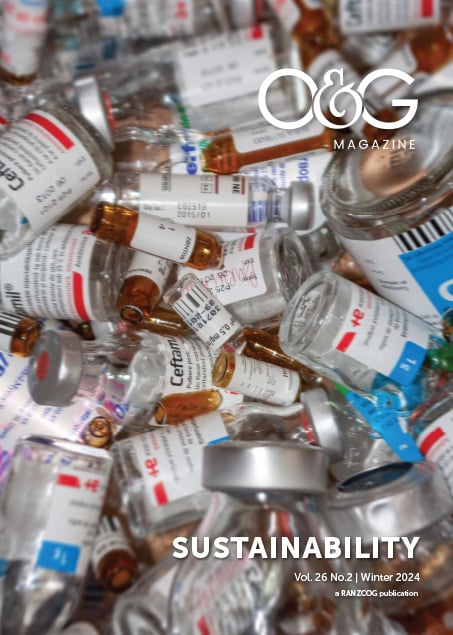Nitrous oxide has an established place in clinical care, particularly in obstetric and paediatric services. However, it is also a powerful greenhouse gas. It is now known that the infrastructure used to deliver nitrous oxide through hospital pipelines to patients is prone to large leaks. As our understanding of this problem grows, so must our resolve to systematically detect and fix nitrous oxide leaks, which contribute to global warming without any contribution to patient care.
A pressing issue
The most recent Intergovernmental Panel on Climate Change report1 concludes that urgent action is needed to limit global warming in order to prevent catastrophic outcomes for the planet and all its inhabitants. The Lancet Countdown of health and climate change states that “climate change is increasingly impacting the health and survival of people worldwide”2. As healthcare providers, we have a responsibility to reduce carbon emissions wherever possible, for the health of our current and future patients.
In Australia, the healthcare sector is responsible for 7% of the country’s total carbon emissions3. Carbon dioxide equivalent emissions from medical nitrous oxide use in Australia was estimated to be 300 kilo tonnes in 2020/214, which is the equivalent of emissions from approximately 67,000 one-way Sydney-London economy flights (according to the myclimate.org carbon calculator).
Nitrous oxide is a potent greenhouse gas with a global warming potential 273 times that of carbon dioxide. It has a long atmospheric lifetime of 110 years, so nitrous oxide released today will have warming effects into the next century.
In hospitals, nitrous oxide is commonly supplied from large cylinders in a central store, or manifold, and delivered to the point of patient care through a network of rigid pipes. Australian hospitals which have passed the recommended Australian Standards for commissioning and maintenance testing of their nitrous oxide pipelines have subsequently been shown to have major leaks5,6,7,8. There is great concern among anaesthetists and other expert groups about unmeasured and ongoing leakage of nitrous oxide from hospital infrastructure, both in Australia and overseas.
Evidence of the problem
Interest in addressing nitrous oxide leaks began in the NHS in 2020, where an audit of 16 hospitals in one region found that, on average, over 90% of nitrous oxide being purchased was wasted via leaks9. This has led to the decommissioning of nitrous oxide infrastructure in a number of hospitals, with ongoing clinical use supported by the provision of portable cylinders to the point of care.
In Australia, significant leaks have been detected across multiple hospitals when specific testing has been performed. These leaks have been detected only when specifically looked for by interested clinicians and engineering departments, reflecting that current Australian Standards for medical gas pipeline testing and maintenance are inadequate.
In 2021, Footscray Hospital in Melbourne found leakage of 75% of total purchased hospital nitrous oxide5. This was equivalent to >75,000kg of carbon dioxide emissions per year, or driving 600,000 km in an average car, and was found to be due to a leaking O-ring at a wall outlet.
At Sir Charles Gairdner Hospital in Perth, investigators found that there was no service contract in place to regularly assess the nitrous oxide infrastructure. In addition, the hospital’s map of the nitrous oxide pipelines was out of date, and when updated it revealed active outlets in areas where the gas was no longer used, including a library6. They have since detected and repaired multiple leaks.
Methods of testing for leakage
A multidisciplinary approach to testing should be used, involving clinical, engineering, and infrastructure staff. Investigation for possible nitrous oxide leaks can be done in several ways, as outlined below. Identified leaks should be fixed, with ongoing scheduled testing put in place to ensure new leaks are detected promptly. Piped nitrous oxide should be removed from areas where it is not clinically necessary, and consideration should be given to replacing pipelines with portable nitrous oxide cylinders in areas where it is required.
Method 1: discrepancy
This method was utilised by The Nitrous Oxide Project, based in the UK9. The amount of nitrous oxide used clinically is compared to the amount of nitrous oxide purchased; the discrepancy between the two represents the size of the leak. This method does not identify where the leaks are in the system. For settings in which clinical use occurs without measuring and recording gas flow rates or duration of use, the clinical use data will need to rely on estimations. A study based at Sunshine Hospital in Melbourne found that, when used in labour, an average of approximately 500 litres of nitrous oxide was used per labour7.
Method 2: cylinder weighing
A single cylinder is attached to the manifold, rather than a bank of cylinders, and weighed over a period of zero clinical administration. A reduction in weight represents a leak. Alternatively, it can be weighed over a period of time and the depletion in weight compared to the clinical administration over the same time period; the discrepancy between the two represents the leak. This method was developed at the Alfred Hospital, Melbourne8.
Method 3: pressure testing
This method detects leaks by measuring a drop in pressure in the fixed volume pipeline during a period of no clinical use. The method was developed in Western Australia, and their protocol is available on the Green Theatres website10.
Method 4: flow monitoring
This method utilises purpose-built flow meters and can be used to quantify the amount of nitrous oxide used in an area of the hospital, and or to detect nitrous oxide leaks in that area. It was developed at Sunshine Hospital7, Melbourne, and is currently being adapted for use in Sydney Children’s Hospital Network and at the Royal Women’s Hospital, Melbourne.
Looking ahead
Investigating for possible nitrous oxide leaks can be done in several ways, but it currently depends on individuals at each hospital becoming aware of the problem and finding the resources required to do the work. Even when the problem is raised by clinicians, hospitals may not consider additional testing to be a priority for them if current Australian standards are currently being followed. Nitrous oxide may be one of the highest single clinical sources of emissions for hospitals, so reductions in its use – or its wastage – can be highly impactful.
There is a need to raise awareness of this problem nationally, and to ensure all hospitals are taking steps to measure and control leaks in their infrastructure. Centralised state and nation-wide databases of nitrous oxide purchasing, clinical use, leaks, and other initiatives would help guide efforts to mitigate the greenhouse gas impact of medical nitrous oxide.
This is an opportunity for the Australian healthcare system to substantially reduce harmful greenhouse gas emissions. Unlike some other measures, the required changes can be undertaken with no impact on clinical care. It is just one of the ways we must step up and ensure that we are providing a responsible and sustainable healthcare system, both for our patients today and in the future.
References
- Intergovernmental Panel on Climate Change. Climate Change 2021: The Physical Science Basis. Contribution of Working Group I to the Sixth Assessment Report of the Intergovernmental Panel on Climate Change. Cambridge, United Kingdom and New York (NY), United States: Cambridge University Press. DOI: 10.1017/9781009157896.
- Romanello M, di Napoli C, Green C, et al. The 2023 report of the Lancet Countdown on health and climate change: the imperative for a health-centred response in a world facing irreversible harms. Lancet. 2023 Dec 16;402(10419):2346-2394. DOI: 10.1016/S0140-6736(23)01859-7.
- Malik A, Lenzen M, McAlister S, McGain F. The carbon footprint of Australian health care. Lancet Planet Health. 2018 Jan;2(1):e27-35. DOI: 10.1016/S2542-5196(17)30180-8.
- Australian Government Department of Health and Aged Care. National Health and Climate Strategy. 2023.
- Seglenieks R, Wong A, Pearson F, McGain F. Discrepancy between procurement and clinical use of nitrous oxide: waste not, want not. Br. J. Anaesth. 2022 Jan;128(1):e32–34. DOI: 10.1016/j.bja.2021.10.021.
- Smith E, Mitchell C. The importance of tackling leaks in nitrous oxide pipes. ANZCA Bulletin. 2023 Mar;32(1):58-9. Available from: search.informit.org/doi/pdf/10.3316/informit.981057534657403.
- Wong A, Gynther A, Li C, et al. Quantitative nitrous oxide usage by different specialties and current patterns of use in a single hospital. Br. J. Anaesth. 2022 Sep;129(3):e59-60. DOI: 10.1016/j.bja.2022.05.022.
- Gaff SJ, Chen VX, Kayak E. A weighing method for measuring nitrous oxide leakage from hospital manifold-pipeline networks. Anaesth Intensive Care. 2024 Mar;52(2):127-130. DOI: 10.1177/0310057X231198123.
- Chakera A, Harrison S, Mitchell J, Oliver C, Ralph M, Shelton C. The Nitrous Oxide Project: assessment of advocacy and national directives to deliver mitigation of anaesthetic nitrous oxide. Anaesthesia. 2024;79(3):270-277. DOI: 10.1111/anae.16211.
- Nitrous oxide medical gas pipeline leak test protocol: for hospitals with active nitrous oxide manifolds and pipelines. Green Theatres Network; 2023. Accessed Apr 5, 2024.
*Photo credit for Dr Emily Balmaks & Rebecca McIntyre’s profile pictures: Julia Nance







Leave a Reply